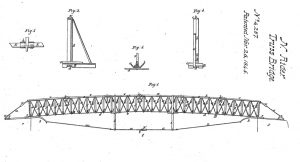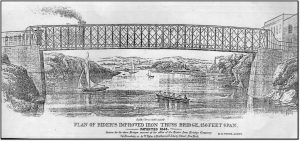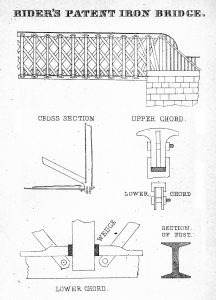This is the first in a series of articles on bridge failures in the United States. While failures are always newsworthy, especially if there is a loss of life, they are also lessons for bridge engineers to learn from. Failures, while traumatic, can be good teachers. Over the coming issues, this series will describe 20 failures, some of which you may have heard of. The earliest failure was in 1850 and the most recent in 1987.
This first article describes a failure of the Rider Bridge, a 66-foot-span cast and wrought iron bridge that crossed the Westcolang Creek, a short distance north of Lackawaxen, Pennsylvania. The bridge had opened about two years earlier and was similar to several of the type built earlier on the New York & Harlem Railroad. The use of iron in bridges in the United States started when the Dunlap’s Creek Bridge, an original suspension bridge by James Finley in 1801, was replaced with a cast iron arch bridge spanning 100 feet over the same creek, built in 1839 by Richard Delafield. It was not until Squire Whipple started to build cast and wrought iron bridges across the Erie Canal with his 1841-patented design that iron bridge building gained momentum. Some of the first ones were by Richard Osborne who built a cast and wrought iron truss railroad bridge at Manayunk for the Philadelphia & Reading Railroad in 1845 and James Millholland who built a 54-foot-span wrought iron plate girder bridge on the Baltimore & Ohio Railroad in 1846 at Bolton Station.
On November 26, 1845, Nathaniel Rider received a patent for a cast and wrought iron bridge and built several for the New York & Harlem Railroad, the first a 40-foot span, carrying streets over the tracks and tracks over streets in Manhattan in the next year. They were generally short spans, less than 60 feet.
He entered his design at the 1846 Annual Fair of the American Institute in New York City. A board of prominent engineers, Horatio Allen, John B. Jervis, and John D. Ward, wrote, “Of Mr. Rider’s Iron Railroad Bridge, the committee would say that, in their opinion, it is of great importance that railroad bridges should be constructed of a less destructible material than wood, and that every effort to obtain that result is entitled to encouragement. Mr. Rider, in his plan, has aimed to effect this object, by a combination of wrought and cast iron, whereby with a limited amount of material the adequate strength is to be obtained. The committee think favorably of the combination, and that for bridges of not too long span, believe that this plan will be found useful; and they, therefore, recommend a favorable notice on the part of the Institute.” It awarded him the Gold Medal for his design. Several engineers, including Alan Campbell of the New York & Harlem Railroad, praised the design. Campbell wrote, “Several road and street bridges over the railroad have also been built on this plan on the Island of New York; these are light, durable, and cheap structures. From my knowledge of Rider’s bridge, obtained from experience on the road, I commend it to favorable notice of railroad companies.”
On the other hand, Squire Whipple was very critical of Rider’s bridge, writing a lengthy article in the November 27, 1847, issue of the American Railroad Journal,
It appears then, that a portion of the wrought iron in the bridge in question is liable to a stress of more than 26,000 lbs. to the square inch, for a dead load on one track, of 1000 lbs. to the foot run, and the bridge endures the daily and rapid transit of the trains of the Harlem railroad.
If, then, bridges be built on the plans I have given in my work on bridges, which are estimated to sustain trains of twice the above weight, of 2000 lbs. to the foot run, with a stress of only 10,000 lbs. to the square inch of wrought iron on any part instead of 26,000 lbs. as above or less that ¼ of the stress for the same load, will not the chances of failure be reduced almost beyond the range of possibility, as far as wrought iron is concerned.
I have not time now to pursue this subject, nor is it necessary to my purpose. I only wished to point to the experimental lesson afforded by the bridge here spoken of.
If I have committed any errors in calculation or otherwise, I shall be very thankful to anyone who will point them out. I am certainly far from expecting to promote my own interest by continuing in error myself or by leading others into error on this subject.
It should be noted that Whipple had written his book on bridges, in 1846 and 1847, in which he had presented, for the first time, a method to analyze determinate trusses. It is unlikely that Rider knew of this method and that he used rule-of-thumb methods, possibly based upon some experience, in bridgework for his design.
Rider improved his bridge without the under deck trussing in an advertisement printed in several journals of the time. The American Railroad Journal, the leading engineering journal of the time, wrote,
There is, perhaps, no department of railroad engineering, which requires, and is so susceptible of improvement, as the construction of bridges, and if the invention of Mr. Rider meets the exigency – as we have reason to believe it does – it should be universally adopted on all of our great lines of railroad.
From an examination of the cut of Mr. Rider’s bridge, engineers will discover that the invention is based upon scientific principles, and that the combination of the trusses is such as to throw the weight of the passing body almost exclusively in the longitudinal direction of the wrought iron tension bars, thereby securing a power of endurance, such as iron alone can give, and which in practice is found to be more than equal to any emergency which the heaviest trains can subject them to. Where these bridges are now in daily use, we have observed that they appear to possess almost the solidity of terra firma; no sensible depression can be detected by the most vigilant observer during the passage of the trains.
The company furnishing these bridges are practiced and careful men, determined that every step taken shall be justified by previous experience; this it is which has hitherto restrained them, in most cases from extending the span much beyond a hundred feet – though a bridge is just now completed at Buffalo of 160 feet, which will be tested during the present week, and which they doubt not will prove in all respects satisfactory, and authorize the building of longer spans, till finally they reach 300 feet – a limit which they deem entirely feasible.
Herman Haupt, in his 1850 General Theory of Bridge Construction, published a plan of Rider’s 70-foot span for the 109th Street Bridge on the New York and Harlem Railroad that was built in 1847. After giving all the dimensions and weights of members, he noted, “The result of this calculation shows that, with the dimensions assumed, the ties are stronger than the chords, and that heavier proportions are required to sustain a load of one ton per foot in addition to the weight of the structure.”
Until the summer of 1850, Rider’s company (he died in 1848) had received the praise of many and convinced several railroads to adopt and build bridges to his design despite the criticism of Whipple and, to a lesser degree, Haupt. On July 31, 1850, his iron bridge on the New York & Erie Railroad failed.
The N.Y. Herald on August 3, 1850, reported the bridge which crossed Hulburt’s Brook went down at “fifteen minutes past one” under the load of an eastbound freight train carrying sheep, cattle, and hogs. The paper reported, “There were seventeen cars besides the engine and tender. At the time the train approached the bridge, it was going at an ordinary rate, but the engine had but just got fairly off the solid track when the engineer heard a crack and felt something giving way, whereupon he put on all the steam possible and succeeded in getting the engine, which was a very powerful one, upon the other side; but just as he cleared the bridge, it went down with a crash, carrying the tender with it; the cars following, tumbled into the abyss one after another.” The report continued, “no one can imagine what caused the bridge to give way. It was inspected only last week, and pronounced perfectly safe. There are but two other iron bridges on the road, and these are small ones. The railroad company has already set hands to build wooden supports to them.” Three men were killed in the wreck, in addition to many sheep, cattle, and hogs.
What followed was a case of an overreaction on the part of the president, Benjamin Loder, and the Board of Directors of the railroad. The president was quoted in the American Railroad Journal of August 24, 1850, as follows,
This iron bridge, the giving way of which caused this accident, was the only one of a kind on the road, and when put up was supposed to be perfectly safe, and to possess many advantages over wooden structures in its greater strength, durability and exemption from fire.
It was not any experiment; but had been used before on several other roads, and had proved satisfactory; It was supposed to be perfectly safe up to the moment of giving way – but the fact of its giving way without any previous warning decides the question in the mind of the directors as to the entire disuse of iron bridges for the future…There are two more small iron bridges [by Squire Whipple] remaining on the road, and those of different make and pattern, and supposed to be perfectly safe, but they will be removed as soon as possible, and in their places supplied with wooden bridges; until their removal they will be secure beyond the reach of accident by wooden supporters. Without expressing any opinion as to the comparative safety of iron or wooden bridges, the directors have decided to use no more iron bridges…
Whipple wrote a long letter to the New York Tribune and the American Railroad Journal under the heading The Breaking of the Iron Bridge on the New York & Erie Railroad, in which he said, in part,
What was the cause of the accident? And how should they affect the confidence in iron bridges generally on railroads are questions in which the public are generally interested, and in which I, being a bridge engineer and builder, am particularly interested. The latter consideration induces me to attempt an answer to these inquiries and the former, I hope will induce others to read and consider, according to their merits, the following remarks and statements…
Now, more than one person can testify to my having frequently remarked, in relation to those bridges, that they were badly proportioned and that in certain parts which I have pointed out, they did not contain half enough iron to render them safe and reliable; that I was surprised that they endured as much as they did and should not be disappointed to hear of their failure at any time…
The cause of the failure, therefore, I conclude to be the bad proportions of the structure and weakness, i.e., want of proper size in some of the parts, defects noticed and frequently spoken of by me (in relation to other bridges on the same plan) years ago; that the accident affords no just grounds of apprehension from iron bridges properly proportioned and constructed, nor of discouragement from the introduction of such bridges on railroads.
Now the most important practical lesson taught by the sad catastrophe which gave occasion to this article, as it appears to me, is that a better understanding of the mechanical principles involved in the construction of bridges should prevail among engineers, and those having charge of such works, and that no structures of the kind, either of wood or iron, should be adopted or admitted, unless scientifically and systematically planned and proportioned throughout.
He then quoted from his 1847 article in the American Railroad Journal in which he pointed out the poor design of the bridge. He was chiefly concerned as the railroad removed several iron bridges he had built on the line. He also wrote a long illustrated letter to Appleton’s Mechanics Magazine and Engineer’s Journal that was published in their January 1851 issue.
Whipple’s colleague, John A. Roebling, who was building suspension aqueducts for the Delaware & Hudson Canal Company in the area, wrote, “Mr. Whipple’s remarks, as far as they go, are perfectly correct, in relation to the ‘Rider’ bridge, although I believe that the weakest points in the combination are at the ends next to the abutments. The investigations of that gentleman will always command the respect of those best able to judge, he having proved himself competent to the task in all his publications on bridge building, a qualification which few bridge builders have a right to claim – most structures of wood or of iron being put up at random, or by the ‘rule of thumb,’ the inventors and constructors very frequently not even understanding the first elements of statics, much less the application of their principles… In conclusion, I would express a hope, that the civil engineers of the United States, in view of their professional standing, will in a body disapprove of the wholesale veto, which the president and directors of the New York and Erie Railroad have seen fit in their wisdom to pass indiscriminately upon all iron bridges.”
Other Rider Bridges also failed shortly after but some survived for extended periods. The Baltimore & Ohio Railroad, under Benjamin Henry Latrobe, did not follow the lead of the New York & Erie and built many iron bridges to the patents of Wendel Bollman and Albert Fink in the 1850s. Squire Whipple built his first double intersection bridge with a span of 146 feet on the Albany Northern Railroad outside of Watervliet (West Troy) in 1853. His design became almost the standard railroad bridge until about 1890.
The failure, the first of an iron railroad bridge, did not stop the construction and failure of many poorly designed and built iron bridges. It did, however, start the slow process in which the railroads retained men, like Whipple, Roebling, Fink, etc., with engineering training to design and build their bridges rather than relying on bridge companies building bridges to their own plans or patents.■



